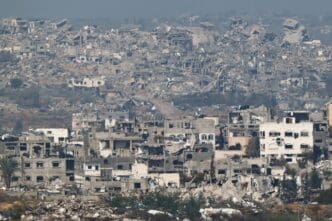Israeli airstrikes on the Gaza Strip have resulted in the deaths of at least 14 Palestinians, predominantly women and children. These attacks also destroyed heavy equipment, including bulldozers, which were provided by mediators for the purpose of clearing debris. In separate incidents on Tuesday, two individuals were killed in Lebanon.
Israel’s ongoing 18-month offensive against Hamas has caused extensive destruction in Gaza, fuelling concerns that the region may face irreparable damage. The area already suffers from a scarcity of heavy machinery, which is crucial for rescuing individuals from the rubble and for clearing essential pathways following Israeli attacks. A municipality in the Jabaliya region of northern Gaza reported that a strike on its parking facility destroyed nine bulldozers provided by Egypt and Qatar. These nations had facilitated a ceasefire that came into effect in January. However, Israel ended the truce last month, resuming its bombardments and ground operations, and blocking all imports into the territory, including essential supplies such as food, fuel, and medical provisions.
The airstrikes further destroyed a water tanker, a mobile generator supplied by aid organizations, and a sewage pumping truck, according to the Jabaliya al-Nazla municipality. The Israeli military has yet to comment on these recent strikes. The military maintains that its targets are militant operatives and attributes civilian casualties to Hamas, arguing that the group operates within densely populated regions.
In a recent airstrike over the southern city of Khan Younis, a multistory residential building was demolished, leading to the deaths of nine individuals, including four women and four children, as per reports from Nasser Hospital. Among the victims were a two-year-old girl and her parents. Another strike in the densely populated Jabaliya refugee camp resulted in the deaths of three children along with their parents, according to emergency services from the Gaza Health Ministry.
The ongoing air and ground conflict has claimed the lives of over 51,000 Palestinians, mostly women and children, as reported by the Gaza Health Ministry. However, the ministry does not distinguish between civilian and combatant casualties. In contrast, Israel claims to have killed approximately 20,000 militants, though it has not substantiated these figures with evidence.
The conflict traces back to an attack by Hamas-led militants on southern Israel on October 7, 2023, which resulted in the death of around 1,200 people, primarily civilians, and the hostage-taking of 251 individuals. Currently, 59 hostages remain, with 24 believed to be alive following various ceasefire agreements and exchanges.
Hamas has declared its willingness to release the remaining hostages in exchange for the release of Palestinian prisoners, a complete Israeli withdrawal, and a permanent ceasefire. Conversely, Israel insists on continuing its operations until all hostages are returned, and Hamas has been neutralized or disarmed and exiled. Israel has vowed to maintain control over designated security zones in Gaza indefinitely.
In Lebanon, an Israeli drone strike near Beirut led to the death of Hussein Atwi, a member of the Lebanese branch of the Muslim Brotherhood. The organization stated that he was struck while heading to work. Additionally, Lebanon’s Health Ministry confirmed another fatality in an Israeli strike on the southern Tyre province, though details remain sparse.
Despite a ceasefire reached with the Hezbollah militant group in November, Israel continues to conduct regular strikes across Lebanon, citing targets as militants and weapons caches. Since the ceasefire, the Lebanese government reports 190 deaths and 485 injuries. The conflict in Lebanon intensified into a full-scale war in September following a significant wave of Israeli strikes that eliminated most of Hezbollah’s leadership.








